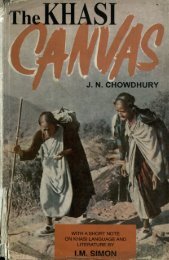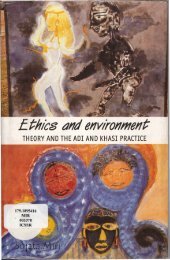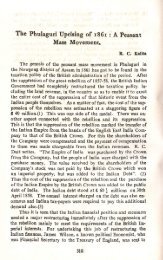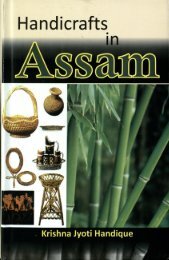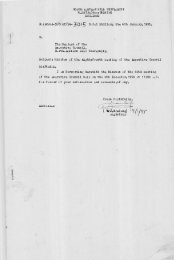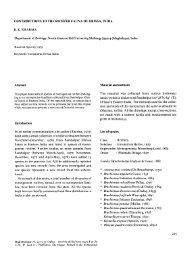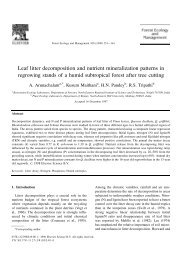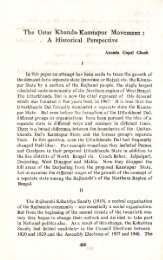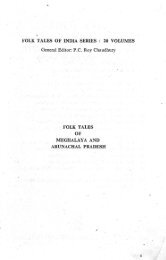Studies on soil fungistasis: Effect of certain ... - DSpace@NEHU
Studies on soil fungistasis: Effect of certain ... - DSpace@NEHU
Studies on soil fungistasis: Effect of certain ... - DSpace@NEHU
You also want an ePaper? Increase the reach of your titles
YUMPU automatically turns print PDFs into web optimized ePapers that Google loves.
Plant and Soil 49, 355-366 (1978) Ms. 3204<br />
STUDIES ON SOIL FUNGISTASIS: EFFECT OF<br />
CERTAIN PHYSICAL AND BIOLOGICAL FACTORS<br />
by R. R. MISHRA*<br />
Department <strong>of</strong> Botany, School <strong>of</strong> Life Sciences, North-Eastern Hill University, Shiil<strong>on</strong>g-3,<br />
India<br />
and K. K. PANDEY<br />
Department <strong>of</strong> Botany, D.A.V. College. Gorakhpur (U.P.) India<br />
SUMMARY<br />
The effect <strong>of</strong> different physical and biological factors like <strong>soil</strong> sterilizati<strong>on</strong>,<br />
incubati<strong>on</strong> period <strong>of</strong> <strong>soil</strong>, spore age, amendment <strong>of</strong> <strong>certain</strong> fungal species and<br />
their metabolites <strong>on</strong> <strong>soil</strong> <strong>fungistasis</strong> has been investigated.<br />
Different degree <strong>of</strong> sterilizati<strong>on</strong> affected the fugistasis differently. Soil<br />
heating above 80~ completely annulled the <strong>fungistasis</strong>. No <strong>fungistasis</strong> was<br />
recorded in <strong>soil</strong> samples steamed for 15 mts in an autoclave.<br />
Incubati<strong>on</strong> <strong>of</strong> <strong>soil</strong> samples to l<strong>on</strong>ger durati<strong>on</strong> resulted in increased <strong>fungistasis</strong>.<br />
Maximum fungistatic value was noted in samples incubated for 15 days<br />
at 25 • I~<br />
Spore age also played important role in <strong>fungistasis</strong>. A positive relati<strong>on</strong> was<br />
noted in the spore age and <strong>fungistasis</strong> upto 30 days <strong>of</strong> age and thereafter the<br />
increase in <strong>fungistasis</strong> was not well marked.<br />
Varying inhibitory effect was noted <strong>on</strong> the spore germinati<strong>on</strong> <strong>of</strong> the test<br />
fungi in relati<strong>on</strong> to amendment <strong>of</strong> <strong>certain</strong> fungi individually and in different<br />
combinati<strong>on</strong>s to the <strong>soil</strong>. Aspergillus [lavus al<strong>on</strong>e and in combinati<strong>on</strong> <strong>of</strong><br />
Aspergillus niger proved most inhibitory. The filtrate <strong>of</strong> the different fungi<br />
also induced <strong>fungistasis</strong> in <strong>soil</strong>. In this case also .d. flavus was most effective.<br />
INTRODUCTION<br />
The origin <strong>of</strong> <strong>soil</strong> <strong>fungistasis</strong> is c<strong>on</strong>sidered to be biological but<br />
which c<strong>on</strong>stituent (s) <strong>of</strong> <strong>soil</strong> micro-populati<strong>on</strong> is (are) particularly<br />
resp<strong>on</strong>sible for this phenomen<strong>on</strong> is not yet clear. The origin <strong>of</strong><br />
<strong>fungistasis</strong> in <strong>soil</strong> by microbial activities is evident from the fact<br />
that it can be completely removed from <strong>soil</strong> by sterilizati<strong>on</strong>, fumi-<br />
* Present address: - Dept. <strong>of</strong> Plant Biology, The University, New Castle up<strong>on</strong> Tyne,<br />
U,K.
356 R. R, MISHRA AND K. K. PANDEY<br />
gati<strong>on</strong> or by l<strong>on</strong>g air drying and that it is lessened when microbial<br />
activities are reduced and can be restored in sterilized <strong>soil</strong> inoculated<br />
with natural <strong>soil</strong>, specific organisms and/or plant materials<br />
s 9<br />
The phenomen<strong>on</strong> <strong>of</strong> <strong>fungistasis</strong>, however, is not yet clearly understood<br />
in relati<strong>on</strong> to different physical and biological factors like<br />
different degree <strong>of</strong> sterilizati<strong>on</strong>, incubati<strong>on</strong> period, spore age,<br />
additi<strong>on</strong> <strong>of</strong> fungal species and their metabolites to the <strong>soil</strong>. In this<br />
paper an effort has been made to investigate the role <strong>of</strong> the <strong>soil</strong><br />
parameters <strong>on</strong> the <strong>soil</strong> <strong>fungistasis</strong> <strong>of</strong> two cultivated fields.<br />
MATERIALS AND METHODS<br />
Soil samples for the study <strong>of</strong> <strong>soil</strong> <strong>fungistasis</strong> were collected from two<br />
cultivated fields cropped with Ca]anus ca]an and Lathyrus sativus. The <strong>soil</strong><br />
samples collected at different stages <strong>of</strong> the plants growth were air dried,<br />
finely powdered and then used for the experiments detailed below.<br />
Soil samples collected were kept separately in an electric oven at 40, 50,<br />
60, 70, 80, 100 and 120~ for 6 hrs and the sterilizati<strong>on</strong> <strong>of</strong> <strong>soil</strong> samples was<br />
d<strong>on</strong>e in autoclave for different time intervals i.e. 5, 10, 15 and 20 mrs at<br />
15 lb/sq, inch pressure. The <strong>soil</strong> samples thus treated were tested for <strong>fungistasis</strong><br />
by method <strong>of</strong> Jacks<strong>on</strong> 5.<br />
Myc<strong>of</strong>lora <strong>of</strong> the above <strong>soil</strong> samples was also estimated by diluti<strong>on</strong> plate<br />
method using Martin's medium.<br />
In another set <strong>of</strong> the experiment the <strong>soil</strong> samples collected from the fields<br />
<strong>of</strong> the two crops after powdering and sieving were packed in the petriplates.<br />
The plates were incubated at 25 :t: 1 ~ for 1, 4, 7 and 15 days and thereafter<br />
<strong>fungistasis</strong> was assessed by a method suggested by J acks<strong>on</strong>5. Throughout<br />
the course <strong>of</strong> study the moisture status <strong>of</strong> the <strong>soil</strong> samples was maintained<br />
at 25 percent, by adding sterilized distilled water.<br />
This part <strong>of</strong> the experiment c<strong>on</strong>sisted <strong>of</strong> the evaluati<strong>on</strong> <strong>of</strong> <strong>fungistasis</strong> in<br />
relati<strong>on</strong> to spore age The spores <strong>of</strong> Rhizopus nigricans, Aspergillus flavus,<br />
.Penicillium oxalicum, Verticillium albo-atrum, Curvularia lunata, Helminthosporium<br />
sativum and Fusarium oxysporum harvested from 7, 10, 15, 20, 25,<br />
30, 45, 60 and 90 days-old culture medium (PDA) were used for the study<br />
<strong>of</strong> <strong>fungistasis</strong> in relati<strong>on</strong> to spore age. The test fungi were maintained in<br />
triplicate for each type <strong>of</strong> spore age. After the desired age the spores were<br />
removed and spore suspensi<strong>on</strong> was prepared in sterilized double distilled<br />
water, centrifuged at 5000 rpm, diluted with sterilized double distilled water<br />
so that each microscopic field c<strong>on</strong>tained about 50 spores. After preincubati<strong>on</strong><br />
(6-8 h) <strong>on</strong>e drop <strong>of</strong> the above suspensi<strong>on</strong> was pipetted out separately <strong>on</strong><br />
agar blocks with a sterilized pipette. Inoculated plates were again incubated<br />
at 25 4- 2~ for 24 h and thereafter the agar blocks were gently removed<br />
from the surface <strong>of</strong> the <strong>soil</strong>. The surface <strong>of</strong> the block which was in c<strong>on</strong>tact
STUDIES ON SOIL FUNGISTASIS 357<br />
with the so il was then sliced <strong>of</strong>f with the help <strong>of</strong> cover glass and kept <strong>on</strong> slide.<br />
All the blocks removed at a time were killed and stained with lactophenol<br />
cott<strong>on</strong> blue and were examined under microscope for the germinati<strong>on</strong> <strong>of</strong><br />
fungal spores. The percentage inhibiti<strong>on</strong> was calculated <strong>on</strong> the basis <strong>of</strong> 1000<br />
spore number counted.<br />
In this part <strong>of</strong> the investigati<strong>on</strong> the effect <strong>of</strong> <strong>soil</strong> amendment with seven<br />
days old cultures <strong>of</strong> Rhizopus nigricans, Mucor hiemalis, Aspergillus niger,<br />
A. [lavus, A. sydowi, A. terreus, Penicillium oxalicum, Curvularia lunata,<br />
A crophialophora ]usispora, A lternaria lumicola, Helminthospor~um sativum<br />
and Fusarium oxysporum <strong>on</strong> fugistasis was studied. Ten circular agar blocks<br />
<strong>of</strong> uniform size (1 cm) <strong>of</strong> the above fungi grown <strong>on</strong> PDA medium were<br />
mixed separately to 50 g <strong>of</strong> sterilized <strong>soil</strong>. The plates were then incubated<br />
at 25:1: I~ for 15 days and thereafter, <strong>fungistasis</strong> was determined. For an<br />
other set <strong>of</strong> this experiments the fungi grown similarly were mixed together<br />
in different combinati<strong>on</strong>s, viz A. niger + A. ]lavus, A. /lavus + A. tenuis,<br />
A. niger -r H. sativum, A. tenuis + F. oxysporum and A. tenuis + H.<br />
sativum. In this case five blocks <strong>of</strong> each c<strong>on</strong>stituent measuring 1 cm in diameter<br />
were mixed and incubated as described above and the <strong>fungistasis</strong> was<br />
assessed. The <strong>fungistasis</strong> <strong>of</strong> sterilized <strong>soil</strong> was also determined for reference.<br />
The effect <strong>of</strong> culture filtrate <strong>of</strong> M. hiemalis, A. niger, A. /lavus, A. sydowi,<br />
P. oxalicum, A. tenuis, H. sativum and F. oxysporum <strong>on</strong> the <strong>fungistasis</strong> was<br />
studied in this experiment. The fungi were grown separately in 250 ml flasks<br />
c<strong>on</strong>taining 100 ml sterilized liquid Czapek's medium in an incubator (25<br />
1 ~ for 15 days, The flasks were intermittently shaken during the incubati<strong>on</strong><br />
period and thereafter the medium was filtered through Whatman filter<br />
paper no. 1 and finally through millipore filter (0.22 ~). The clear soluti<strong>on</strong><br />
thus obtained was designated as culture filtrate. The culture filtrate <strong>of</strong> above<br />
fungi was mixed with sterilized <strong>soil</strong> at the rate <strong>of</strong> 1 ml per 10 g <strong>of</strong> <strong>soil</strong> and the<br />
<strong>fungistasis</strong> was assessed.<br />
In all the experiments the <strong>fungistasis</strong> was assessed by the method suggested<br />
by J a c ks o n 5 and the test organisms used were Rhizopus n,gricans,<br />
Aspergillus [lavus, Penicillium oxalicum, Verticillium albo~atrum, Curvularia<br />
lunata, Helminthosporium sativum and Fusarium oxysporum. The <strong>fungistasis</strong><br />
has been expressed in terms <strong>of</strong> percentage inhibiti<strong>on</strong> which has been calculated<br />
<strong>on</strong> the basis <strong>of</strong> 1000 spore number counted.<br />
RESULTS<br />
E/[ect o/sterilizati<strong>on</strong> <strong>on</strong>/ungistasis<br />
(i) Oven sterilizati<strong>on</strong>. A perusal <strong>of</strong> the table 1 indicates that<br />
as the temperature increases the fungistatic value decreased. The<br />
<strong>fungistasis</strong> was very much reduced at 80~ At 100~ and above<br />
the <strong>fungistasis</strong> was lost.<br />
The <strong>soil</strong> samples <strong>of</strong> L. sativus field exhibited higher fungistatic<br />
value than the samples from C. caian field. The organisms tested
358 R. R. MISHRA AND K. K. PANDEY<br />
TABLE 1<br />
<strong>Effect</strong> <strong>of</strong> <strong>soil</strong> sterilizati<strong>on</strong> (in hot air oven) <strong>on</strong> <strong>fungistasis</strong><br />
Temp. Test fungi Mycopopulati<strong>on</strong><br />
(~ RN AF PO VA CL HS FO (cols./plate)<br />
caj~nus c~jan<br />
40 74 83 82 54 32 33 52 57<br />
50 66 72 71 38 26 28 28 39<br />
60 58 59 61 23 12 13 12 27<br />
70 43 48 50 16 7 1 4 12<br />
80 33 36 41 0 0 0 0 2<br />
100 24 35 28 0 0 0 0 0<br />
120 26 30 27 0 0 0 0 0<br />
Lathyrus sativus<br />
40 77 86 82 67 38 35 54 104<br />
50 70 79 76 43 26 29 36 62<br />
60 59 62 66 26 9 11 13 36<br />
70 37 45 57 10 2 2 6 11<br />
80 26 37 44 0 0 0 0 3<br />
100 25 33 28 0 0 0 0 0<br />
120 23 32 28 0 0 0 0 0<br />
C<strong>on</strong>trol<br />
26 31 28 0 0 0 0<br />
RN ~ Rhizopus nigricans, AF = Aspergillus ]lavus, PO = Penicillium oxalicum, VA<br />
VerticilIium albo-atrum, CL = Curvularia lunata, HS = Helminthosporium sativum,<br />
FO = Fusarium oxysporum.<br />
TABLE 2<br />
<strong>Effect</strong>s <strong>of</strong> steam sterilizati<strong>on</strong> <strong>of</strong> <strong>soil</strong> <strong>on</strong> <strong>fungistasis</strong><br />
Time <strong>of</strong><br />
sterilizati<strong>on</strong><br />
Test fungi Mycopopulati<strong>on</strong><br />
in mts RN* AF PO VA CL HS FO (cols./plate)<br />
Cajanus cajan<br />
5 64 69 62 45 31 36 37 45<br />
10 39 46 41 13 5 3 9 17<br />
15 23 30 29 0 0 0 0 0<br />
20 24 26 31 0 0 0 0 0<br />
Lathyrus sativus<br />
C<strong>on</strong>trol<br />
S 69 78 71 55 31 38 48 59<br />
10 42 44 40 34 3 6 13 34<br />
1S 24 32 31 0 0 0 0 0<br />
20 13 31 29 0 0 0 0 0<br />
25 30 28 0 0 0 0 0<br />
* see Table 1
STUDIES ON SOIL FUNGISTASIS 359<br />
showed following trend <strong>of</strong> variati<strong>on</strong>: A. /lavus > P. oxalicum > R.<br />
nigricans > V. albo-atrum > F. oxysporum > H. sativum > C.<br />
lunata in case <strong>of</strong> both the sets <strong>of</strong> <strong>soil</strong>. Decrease in myc<strong>of</strong>iora was<br />
noted when the temperature increased and above 80~ no fungi<br />
were recorded (Table 1).<br />
(ii) Steam sterilizati<strong>on</strong>. The trend <strong>of</strong> variati<strong>on</strong> in fungistatic<br />
values <strong>of</strong> the different fungi was nearly the same as in case <strong>of</strong> oven<br />
sterilizati<strong>on</strong>. No <strong>fungistasis</strong> was noted in the <strong>soil</strong> samples steamed<br />
for 15 rots and above (Table 2).<br />
The mycopopulati<strong>on</strong> also decreased with increase in steaming<br />
period. After 15 mrs <strong>of</strong> steaming no fungal species could be isolated<br />
from the <strong>soil</strong> samples (Table 2).<br />
Evaluati<strong>on</strong> o t ]ungistasis in relati<strong>on</strong> to incubati<strong>on</strong> period<br />
Increase in <strong>fungistasis</strong> was marked with increase in incubati<strong>on</strong><br />
period. The <strong>soil</strong> samples incubated for 15 days exhibited maximum<br />
fungistatic value. Generally the <strong>fungistasis</strong> <strong>of</strong> C. caian <strong>soil</strong> was higher<br />
than that <strong>of</strong> L. sativus. The sensitivity <strong>of</strong> different test organisms<br />
to <strong>fungistasis</strong> varied greatly and was generally maximum in the<br />
case <strong>of</strong> A. ]lavus. Other fungal species exhibited the following<br />
pattern; R. nigricans > V. albo-atrum > C. lunata > F. oxysporum<br />
> H. sativum (Ca~anus ca~an) and R. nigricans > V. albo-atrum ><br />
F. oxysporum > H. sativum > C. lunata (Lathyrus sativus) (Figs.<br />
1 and 2).<br />
EHect o! spore age <strong>on</strong> <strong>soil</strong> ]ungistasis<br />
With increase in spore age, increase in <strong>soil</strong> <strong>fungistasis</strong> was recorded<br />
for all the test fungi. Soil samples exhibited marked increase<br />
in <strong>fungistasis</strong> upto 30 days <strong>of</strong> spore age and thereafter the figures<br />
obtained for <strong>fungistasis</strong> did not vary much (Fig. 3).<br />
Am<strong>on</strong>gst the various <strong>soil</strong> samples amended with individual fungal<br />
species maximum <strong>fungistasis</strong> was recorded in <strong>soil</strong> amended with A.<br />
flavus. The remaining fungal species exhibited following trend <strong>of</strong><br />
variati<strong>on</strong> in <strong>fungistasis</strong>: A. niger > H. sativum > P. oxalicum ><br />
A. terreus > A. sydowi > F. oxysporum > A. tenuis > C. lunata ><br />
R. nigricans > A. [usispora > H. hiemalis in case <strong>of</strong> Caianus caian ;<br />
A. niger > A. sydowi > P. oxalicum > A. terreus > H. sativum ><br />
F. oxysporum > A. tenuis > C. lunata > A. lusispora > R. nigricans<br />
> M. hiemalis in case <strong>of</strong> Lathyrus sativus (Table 3).
360<br />
R. R. MISHRA AND K. K. PANDEY<br />
100<br />
80<br />
60<br />
40<br />
20<br />
i<br />
M ARCH<br />
~RN<br />
OAF<br />
~VA<br />
IICL<br />
E]HS<br />
[]FO<br />
CONTROL<br />
Ld<br />
(_9<br />
<<br />
v--<br />
Z<br />
LO<br />
(D<br />
cY<br />
Ill<br />
Q_<br />
Z<br />
O<br />
F--<br />
CO<br />
I<br />
Z<br />
..80<br />
60<br />
40<br />
20<br />
%2~,, I.<br />
0<br />
1 4 7 15 '<br />
4 7 15<br />
INCUBATION PERIOD (IN DAYS)<br />
(CA JANUS CA JAN)<br />
Fig 1.<br />
<strong>Effect</strong> <strong>of</strong> length o2 incubati<strong>on</strong> period <strong>on</strong> rate <strong>of</strong> <strong>fungistasis</strong> (percentage<br />
inhibiti<strong>on</strong>).
STUDIES ON SOIL FUNGISTASIS<br />
361<br />
LATHYRUS<br />
SATIVUS<br />
MARCH<br />
CONTROL<br />
I.O<br />
(_9<br />
<<br />
v--<br />
Z<br />
ta3<br />
(D<br />
cv<br />
k13<br />
Q_<br />
O<br />
V--"<br />
m<br />
m<br />
T<br />
Z<br />
1 4 7 15 1 4 7 15<br />
Fig. 2.<br />
INCUBATION PERIOD (IN DAYS)<br />
<strong>Effect</strong> <strong>of</strong> length <strong>of</strong> incubati<strong>on</strong> period Oll rate <strong>of</strong> <strong>fungistasis</strong> (percentage<br />
inhibiti<strong>on</strong>).<br />
Maximum <strong>fungistasis</strong> was observed in the <strong>soil</strong> samples amended<br />
with the mixture <strong>of</strong> A./lavus and A. niger. In other sets the value<br />
obtained was comparatively low (Table 3).
369-<br />
R. R. MISHRA AND K. K. PANDEY<br />
100<br />
80<br />
60<br />
40<br />
20<br />
Z<br />
0 8o<br />
j-<br />
CL<br />
HS<br />
I"-<br />
6O<br />
m<br />
"1- 4o<br />
Z<br />
--" 20<br />
v--<br />
Z<br />
LLI 80<br />
(D<br />
hi<br />
60<br />
13- 4o<br />
FIN<br />
S ~ lit ii<br />
20<br />
AF<br />
I I I I I I l i 9<br />
I I I I ,t I I I L<br />
7 10 15 2025 3045 6090 7 10 15 2025 30 456090<br />
Fig. 3.<br />
SPORE AGE IN DAYS<br />
(~ ~ CA JANUS CA JAN ~ ; CONTROL)<br />
= = L AT H~'9,US S AT~VLI$.<br />
<strong>Effect</strong> <strong>of</strong> Spore age <strong>on</strong> <strong>soil</strong> <strong>fungistasis</strong>.
STUDIES ON SOIL FUNGISTASIS 363<br />
TABLE 3<br />
Variati<strong>on</strong> in <strong>fungistasis</strong> in <strong>soil</strong> samples <strong>of</strong> Ca]anus cajan and Lathyrus sativus ametlded with <strong>certain</strong><br />
fungal species<br />
Fungi amended<br />
Test fungi<br />
RN* AF PO VA CL HS FO<br />
Rhizopus nigricans 27(29)** 42(33) 31(30) 25(32) 12(19) 11(15) 22(23)<br />
Mucor hiemalis 24(28) 37(35) 28(25) 27(29) 11(14) 9(13) 19(21)<br />
Aspergillus niger 64(71) 94(97) 81(86) 89(I 00) 58(61) 69(64) 77(81)<br />
A. /lavus 69(77) 100(100) 85(90) 97(100) 67(67) 72(69) 81(87<br />
A. sydowi 59(67) 91(91) 77(81) 81(91) 51(58) 52(61) 64(80<br />
A. terreus 61(65) 93(93) 79(84) 83(93) 53(54) 54(63) 66(76<br />
Penicillium oxalicum 63(66) 95(96) 69(95) 87(94) 55(56) 57(65) 68(77<br />
Acrophialophora/usipora 26(32) 40(31) 34(27) 30(36) 15121) 8(16) 26(27<br />
Curvularia lunata 31 (37) 48(38) 35(31 ) 37(44) 19(25) 13(18) 33(33<br />
Helminthosporium sativum 66(63) 96(95) 81 (77) 86(87) 58(55) 61 (56) 74(69<br />
Alternaria tenuis 37(46) 49(54) 42(39) 44(51) 27(29) 29(33) 41(41<br />
Fusarium oxysporum 58(61) 89(87) 73(74) 81(79) 53(53) 56(57) 68(70<br />
A. niger + A. ]lavus 72(82) 100(100) 84(94) 100(100) 87(71) 94(78) 89(84<br />
A. /lavus + A. tenuis 70(85) 100(100) 81(91) 100(100) 84(69) 91(75) 92(79<br />
A. niger + H. sativum 69(81) 100(100) 80(89) 100(100) 81(67) 89(73) 90(83<br />
A. r + F. oxysporum 66(74) 94(100) 82(86) 94(100) 80(64) 87(71) 89(81<br />
A. tenuis + H. sativum 63(83) 96(100) 83(90) 91(100) 82(63) 83(77) 94(85<br />
Sterilized <strong>soil</strong> 22(25) 29(28) 27(23) 21 (24) 9( 11 ) 6(12) 13( 17<br />
C<strong>on</strong>trol 17(19) 25(26) 21(19) 16(17) 7(9) 6(6) 14(12<br />
* See Table 1 ; ** Figures in the brackets stand for L. sativus<br />
E//ect o/[ungal metabolites<br />
The <strong>soil</strong> samples amended with fungal metabolites exhibited<br />
much variati<strong>on</strong> in fungistatic values. Maximum effect was observed<br />
in the samples amended with metabolites <strong>of</strong> A./lavus followed by<br />
A. niger, H. sativum, A. tenuis, P. oxalicum, A. sydowi, F. oxysporum,<br />
M. hiemalis in Caianus caian <strong>soil</strong>, and A. niger, H. sativum, P.<br />
oxalicum, A. sydowi, A. tenuis F. oxysporum, M. hiemalis in Lathyrus<br />
sativus <strong>soil</strong> (Table 4).<br />
Significant variati<strong>on</strong> was observed in the fungistatic value <strong>of</strong> the<br />
test fungi amended with fungal filtrate <strong>of</strong> the different fungi<br />
(P ----- 0.05).<br />
DISCUSSION<br />
It is evident from table 1 and 2 that sterilizati<strong>on</strong> <strong>of</strong> the <strong>soil</strong><br />
samples removed the fungistatic effect. Different degree <strong>of</strong> steriliza-
364 R.R. MISHRA AND K. K. PANDEY<br />
TABLE 4<br />
<strong>Effect</strong>s <strong>of</strong> cultural filtrate <strong>of</strong> <strong>certain</strong> fungi <strong>on</strong> <strong>fungistasis</strong> <strong>of</strong> Ca]anus ca]an and Lathyrus sativus field sol<br />
Fungi used<br />
Test fungi<br />
RN* AF PO VA CL HS FO<br />
Mucor hiemalis 22(25)** 31(37) 23(30) 27(29) 15(11) 14(13) 20(17)<br />
Aspergillus niger 83(92) 100(97) 98(94) 95(58) 75(77) 73(79) 87(91)<br />
A. ]lavus 84(100) 100(100) 99(100) 96(100) 77(81) 76(84) 89(100)<br />
24. sydowi 71(77) 83(89) 79(83) 87(84) 65(68) 68(69) 78(74)<br />
Penicillium oxalicum 75(79) 84(91) 82(85) 86(78) 57(61) 59(63) 80(68)<br />
Helminthosporium sativum 79(83) 89(98) 82(89) 82(85) 65(61) 64(56) 71(58)<br />
Alternaria tenuis 77(79) 85(89) 81(84) 79(73) 62(61) 61(88) 67(68)<br />
Fusarium oxysporum 65(59) 70(67) 77(63) 54(62) 38(38) 46(41) 45(49)<br />
Czapek's soluti<strong>on</strong> 6(9) 14(11) 8(6) 0(0) 0(0) 0(0) 0(0)<br />
Water 17(15) 23(26) 19(21) 17(19) 9(10) 10(7) 16(13)<br />
C<strong>on</strong>trol 16(15) 25(23) 20(19) 17(16) 8(8) 7(7) 12(11)<br />
* See Table 1 ** Figures ill the brackets stand for L. sativus<br />
ti<strong>on</strong> affected the <strong>fungistasis</strong> differently. The minimum <strong>fungistasis</strong><br />
was recorded in the <strong>soil</strong> which was fully sterilized. Dobbs and<br />
Hins<strong>on</strong> 1 have c<strong>on</strong>cluded that autoclaving destroys the toxic microorganisms<br />
present in <strong>soil</strong> during sterilizati<strong>on</strong>. Increase in <strong>fungistasis</strong><br />
in sterilized <strong>soil</strong> reinoculated with Streptomyces spp., bacteria<br />
and fungi has been reported by various workers 2 7 s n. Griffiths<br />
and Dobbs 4 dem<strong>on</strong>strated that autoclaved <strong>soil</strong> released a high<br />
c<strong>on</strong>centrati<strong>on</strong> <strong>of</strong> reducing sugars into the <strong>soil</strong> which annulled the<br />
<strong>fungistasis</strong> <strong>of</strong> <strong>soil</strong>.<br />
A c<strong>on</strong>tinuous increase in <strong>fungistasis</strong> with the increase in incubati<strong>on</strong><br />
period was clearly marked (Figs 1-2). Incubati<strong>on</strong> <strong>of</strong> <strong>soil</strong><br />
samples under adequate moisture c<strong>on</strong>diti<strong>on</strong> and suitable temperature<br />
to l<strong>on</strong>ger durati<strong>on</strong> probably encouraged the multiplicati<strong>on</strong> <strong>of</strong><br />
<strong>soil</strong> microbes which ultimately induced higher degree <strong>of</strong> <strong>fungistasis</strong>.<br />
Besides this, the l<strong>on</strong>ger durati<strong>on</strong> <strong>of</strong> incubati<strong>on</strong> probably resulted in<br />
accumulati<strong>on</strong> <strong>of</strong> higher amount <strong>of</strong> fungistatic factor which ultimately<br />
induced high <strong>fungistasis</strong>.<br />
From the findings presented in Fig. 3 it is evident that as the age<br />
<strong>of</strong> the spores <strong>of</strong> the test fungi increases, the inhibiti<strong>on</strong> percentage<br />
is also enhanced. This variati<strong>on</strong> in spore germinati<strong>on</strong> was not much<br />
marked in the spore aged 25 days or more. With the advancement<br />
<strong>of</strong> spore age the viability <strong>of</strong> the fungus spores decreases which<br />
possibly resulted in increase in <strong>fungistasis</strong>.
STUDIES ON SOIL FUNGISTASIS 365<br />
The different fungal species isolated from the rhizosphere <strong>of</strong> the<br />
two plants when inoculated in sterilized <strong>soil</strong> samples individually<br />
and in different combinati<strong>on</strong>s inhibited the fungal spore germinati<strong>on</strong><br />
<strong>of</strong> the test fungi (Table 3). A. ]lavus al<strong>on</strong>e and in combinati<strong>on</strong><br />
with A. niger proved highly fungistatic for the fungi tested. Both<br />
the fungi menti<strong>on</strong>ed are well known for producti<strong>on</strong> <strong>of</strong> organic acids<br />
which probably affected the spore germinati<strong>on</strong> <strong>of</strong> the fungi under<br />
test. Fast growing habit and heavy sporulating nature <strong>of</strong> the two<br />
fungi may also affect the test fungi by nutrient deprivati<strong>on</strong> in <strong>soil</strong>.<br />
Kiem and Webster 6 indicated that microbial activity was resp<strong>on</strong>sible<br />
for the inhibiti<strong>on</strong> <strong>of</strong> germinati<strong>on</strong> <strong>of</strong> sclerotia <strong>of</strong> S. oryzae.<br />
Inhibiti<strong>on</strong> was observed when the organisms were tested individually<br />
or in different groups. They suggested that inhibiti<strong>on</strong> <strong>of</strong> the<br />
sclerotia was probably due to formati<strong>on</strong> <strong>of</strong> <strong>certain</strong> inhibitory<br />
substances by the organisms used. Similar results were also obtained<br />
by the authors in the present investigati<strong>on</strong>. The metabolites <strong>of</strong><br />
different fungi when amended induced <strong>fungistasis</strong> (Table 4). P a r k 10<br />
remarked that the growth <strong>of</strong> a fungus may be inhibited by the accumulati<strong>on</strong><br />
<strong>of</strong> autotoxic metabolic by products or staling substances<br />
and not by the depleti<strong>on</strong> <strong>of</strong> nutrients or <strong>of</strong> space. Griffin 3 also<br />
suggested that the fungistatic effect <strong>of</strong> natural <strong>soil</strong> may result in<br />
part from the general saprophytic activities <strong>of</strong> the <strong>soil</strong> micr<strong>of</strong>lora,<br />
and toxic metabolites other than specific antibiotic substances.<br />
Lockwood and Lingappa s noted that sterilized <strong>soil</strong> inoculated<br />
with various fungi, actinomycetes and bacteria produced some<br />
inhibitory effect <strong>on</strong> fungal spore germinati<strong>on</strong> while others did not<br />
show any such effect when tested against Glomerella cingulata.<br />
In c<strong>on</strong>clusi<strong>on</strong> it may be said that the <strong>fungistasis</strong> in <strong>soil</strong> is a c<strong>on</strong>sequence<br />
<strong>of</strong> microbes inhabiting the envir<strong>on</strong>ment. The mode <strong>of</strong><br />
their acti<strong>on</strong>, however, is still not clear from the results <strong>of</strong> the<br />
present investigati<strong>on</strong>. Whether they affect the spore germinati<strong>on</strong>s<br />
directly or through their metabolites is c<strong>on</strong>troversial because when<br />
tested either way the effect is inhibitory.<br />
ACKNOWLEDGEMENT<br />
Authors are thankful to the Head <strong>of</strong> the Department <strong>of</strong> Botany, University<br />
<strong>of</strong> Gorakhpur, Gorakhpur, for providing laboratory facilities to complete this<br />
work.<br />
Received 6 June 1976
366 STUDIES ON SOIL FUNGISTASIS<br />
REFERENCES<br />
1 Dobbs, C. G. and Hins<strong>on</strong>, W. H., A wide-spread <strong>fungistasis</strong> in <strong>soil</strong>s. Nature<br />
L<strong>on</strong>d<strong>on</strong> 172, 197-199 (1953).<br />
2 Dwivedi, R. and Dwivedi, R. S., Development <strong>of</strong> <strong>fungistasis</strong> in sterile <strong>soil</strong> inoculating<br />
<strong>soil</strong> inhabiting fungi. Abstr. Proe. Natl. Acad. Sci. India 165, (1970).<br />
3 Griffin, G. J., Producti<strong>on</strong> <strong>of</strong> a fungistatie effect by <strong>soil</strong> mier<strong>of</strong>lora in autoclaved<br />
<strong>soil</strong>. Phytopathology 5:1, 90-91 (1962).<br />
4 Griffiths, D. A. and Dobbs, C. R., Relati<strong>on</strong>ships between myeostasis and free<br />
m<strong>on</strong>osaecharides in <strong>soil</strong>s. Nature L<strong>on</strong>d<strong>on</strong> 199, 408 (1963).<br />
5 Jacks<strong>on</strong>, R. M., An investigati<strong>on</strong> <strong>of</strong> <strong>fungistasis</strong> in Nigerian <strong>soil</strong>s. J. Gen. Mierobiol.<br />
18, 248 (1958).<br />
6 Keim, R. and Webster, R. K., Fungistasis <strong>of</strong> sclerotia <strong>of</strong> Sclerotia oryzae. Phytopathology<br />
65, 283-287 (1975).<br />
7 Lockwood, J. L., Streptomyces spp. as a cause <strong>of</strong> natural fungitoxicity in <strong>soil</strong>s.<br />
Phytopathology 49, 327-331 (1959).<br />
8 Lockwood, J. L. and Lingappa, B. T., Fungitoxieity <strong>of</strong> autoclaved <strong>soil</strong> inoculated<br />
with <strong>soil</strong> mier<strong>of</strong>lora. Phytopathology 53, 917-920 (1963).<br />
9 Mishra, R. R. and Kanaujia, R. S., Observati<strong>on</strong>s <strong>on</strong> <strong>soil</strong> <strong>fungistasis</strong> III. Fungistasis<br />
in relati<strong>on</strong> to <strong>soil</strong> depths, seas<strong>on</strong>al changes, <strong>soil</strong> amendments and physicochemical<br />
characteristics <strong>of</strong> <strong>soil</strong>. Plant and Soil 38, 321-330 (1973).<br />
10 Park, D., Antag<strong>on</strong>ism: The Background in Soil fungi. In The Ecology <strong>of</strong> Soil Fungi,<br />
pp. 148-159, D. Parkins<strong>on</strong> and J. S. Waid eds., Liverpool University Press (1960).<br />
11 Steiner, G. W. and Lockwood, J. L., Soil <strong>fungistasis</strong>. Mechanism in sterilized,<br />
reinoculated <strong>soil</strong>. Phytopathology 60, 89-91 (1970).



